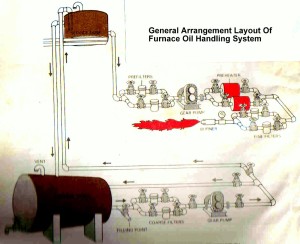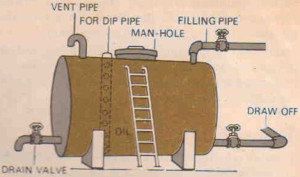OIL TRANSFER PUMPING UNITS
 How To Store Furnace Oil
How To Store Furnace Oil
Furnace oil is best stored in cylindrical tanks either above or below the ground. Generally, the main storage tank is erected above ground when the capacity exceeds 70,000 litres. For lower capacities, underground storage may be more economical. When erecting a storage tank above ground, remember to maintain safety distances from the surrounding structures, as prescribed by the Explosives Department.
Storage tanks are generally made from welded mild steel plates. The overhead tank should be mounted on concrete blocks, which provide a slight gradient of 1:50 towards the drain valve.
Each of the following fittings has a definite role to play.
The Outlet or Draw-Off Pipe should be located at the raised tank end, not less than 15 cms. from the bottom.
The Vent Pipe, of gooseneck type, should be located at the highest point of the tank to facilitate filling by venting air and oil vapour during the filling operation. It should be at least 5 cms. in diameter and provided with a strainer at the outlet.
The Fill-Pipe could be located either at the top or at the bottom of the tank. If located at the top, it must be ensured that the pipe descends almost to the bottom of the tank.When located near the bottom, it is important to position a non-return valve on the line to avoid furnace oil re-entry into the tank-truck on account of back pressure. To avoid leakage of oil during decanting, it is advisable to have a camlock coupling at the filling end so that it fits snugly on the delivery hose.
The Drain Pipe, which is fitted at the lower tank end bottom, is used top periodically remove the accumulated water. It is a difficult task to drain the water and sludge from underground storage tanks. The water and sludge which settle down at the bottom should, however, be removed by a handpump. It would be advantageous to have two suction pipes-one at a lower level and the other at a higher level-so that in case the sludge accumulation is up to the lower point and the suction line chokes up, the alternative line could be put into operation and adequate time would be available to decide upon a time schedule for cleaning the tank.
Furnace oil as delivered may contain dust, dirt, gummy matter and water. During storage for prolonged periods, these tend to form sludge which accumulates in the various ‘dead spaces’ of the tank, where the oil is not agitated during normal operations of the tank. This results in unsteady flames and clogging of filters. To avoid this, some means of agitation of oil in the tank may be necessary
The Service Tank
In addition to the main storage tank(s), industries may have one or a number of day service tanks located in proximity to the units consuming oil.
The principles enumerated earlier for the maintenance of main storage tanks apply here too. The service tank may be sized for a shift’s consumption or daily consumption-the choice depends on capacity required, ease of location of tank near the shop, pumping capacity, horse power, etc. certain additional precautions may, however, be taken with respect to service tanks:
a) Service tanks should not be located very near or above furnaces, hot air or process ducts, etc.
b) They may be provided with overflow pipes which lead directly below to a sump. As a further refinement, limit switches could be provided to avoid the possibility of oil overflow.
c) In gravity feed systems, the difference in height between the service tank and the burners should be at least 10 metres.
Removal of contaminants
Furnace oil should be free from possible contaminants such as dirt, sludge and water before it is finally fed to the combustion system.
Furnace oil arrives at the factory site either in tank lorries by road or by rail. Oil is then decanted into the main storage tank. To prevent the possibility of contaminants such as rags,cotton waste,loose nuts or bolts or screws from entering the system and damaging the pump, position a coarse strainer of 10 mesh size (not more than 3 holes per linear inch) on the entry pipe to the storage tanks. Progressively finer strainers should be provided at various points in the oil supply system to filter away finer contaminants such as external dust and dirt, sludge or free carbon. It is advisable to provide these filters in duplicate to enable one filter to be cleaned while oil supply is maintained through the other. Figure below gives an illustration of the duplex system of arrangement of strainers.
Sizing of Strainers
A Sluggish Problem
Our problem now is only partially over. Furnace oil increases in viscosity as temperature drops, which makes handling a little difficult, particularly in winter. At low ambient temperatures (below 25 oC), furnace oil is not easily pumpable. The oil supplying companies should be approached to ascertain the correct – pre – heating temperature for easy pumping of furnace oil, as its viscosities are subject to seasonal changes.
The preheating of oil in the storage tank to render it pumpable can be accomplished in two ways. Either the entire tank can be maintained at the pumping temperature (bulk heating) or an outflow heater may be fitted to heat the oil as it flows out. Bulk heating, which uses steam coils (Fig. 6) positioned at the floor of the tank, requires additional heat to compensate for the heat losses from the tank surface. To reduce steam requirements, it is advisable to insulate tanks where bulk heating is used.
In the case of outflow heating, only the oil which leaves the tank is heated to the pumping temperature.
While the outflow heater is the preferred choice, bulk heating may be necessary where flow rates are so high that outflow heaters of adequate capacity cannot be easily installed, or when using special fuels such as low sulphur heavy stock (LSHS).
The outflow heater is essentially a heat exchanger, with steam or electricity as the heating medium. The heater protrudes from the suction connection into the oil space.
Important
Thermostatic temperature control of the oil is necessary to prevent overheating, especially when oil flow is reduced or stopped. This is particularly important for electric heaters, since oil may get carbonized when there is no flow and the heater is on.
Thermostats should be provided at a region where the oil flows freely into the suction pipe.
Preparation Of Furnace Oil For Combustion
The preheating of furnace oil in the storage tanks renders it pumpable. However, furnace oil generally has to be heated further so that its viscosity is appreciably lowered to suit the burner. This operation is extremely vital if we are to ensure that furnace oil is properly atomized by the burner – an essential condition for efficient combustion. A thermometer should, therefore, be provided on the oil line.
A standard temperature viscosity chart could be used to obtain the correct preheat temperature.
The oil can be preheated by either electricity or steam. The capacity of the preheater depends on the oil flow rate and the required rise in temperature.
It is essential that preheaters are provided with a thermostatic control to prevent oil carbonization when flow is stopped. It would be a good practice to insulate the preheater as well as the oil delivery line from the preheater right upto the burners. During start-ups, cold oil may be present in the oil lines upstream of the preheater. It should be drained by providing suitable drain cocks on the line.






